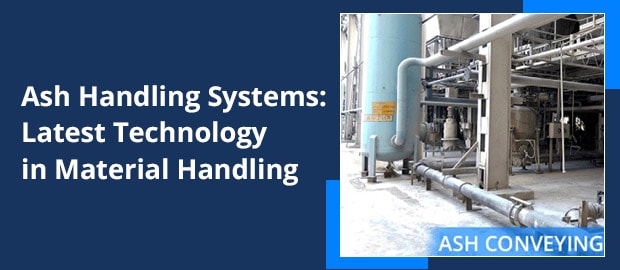In a typical thermal power plant, coal is utilized as a source of fuel to generate electricity. Once the coal is burned, around 40% of total coal consumption gets converted into ash. Ash is then required to be disposed of properly from the thermal power plant. The process is referred to as ‘Ash Handling’, and the systems responsible for ensuring the same are ‘Ash Handling Systems, one the newest technologies for materials handling.
In a thermal power plant, different types of ash are generated and dealt with separately. These are:
- Fly Ash : Around 80 percent of ash produced in a thermal power plant comprises fly ash. It is present in the form of minute particles collected with the help of an economizer hopper, ESP (Electrostatic precipitator), and air-preheater hopper.
- Bottom Ash : It is the ash that is produced right below the furnace of any thermal power plant. It is around 20% of the total ash produced in any thermal power unit. The bottom ash is slightly coarse. Therefore, it requires further crushing before getting transported to a dedicated ash handling system.
A typical ash handling system in a thermal power plant comprises different components for cooling down the collected ash to manageable temperatures. The ash is then transferred to some disposal area or a dedicated storage area. From there, it is further utilized in different industries.
Ready to Upgrade Your Ash Handling System?
A] The Different Parts of the Ash Handling Systems
A standard ash handling system might use the pneumatic ash collection procedure from different pickup stations. In addition to collecting ash, there are several different steps that should be executed in a typical ash handling system. Some common parts to handle the same are:
- Dome Valve : It is shaped like a dome and referred to as National D or Disk Type valve. The valve is responsible for handling the intake of ash at different ash pickup stations. The Dome valve is a type of system valve primarily present in a vacuum pneumatic ash collection system.
- Dense Phase Conveying Vessel :The dense phase ash conveying vessel is a pneumatic pressure-based system responsible for conveying collected dense ash at a reduced velocity. The entire system consumes less energy because of smaller volumes of conveying air. This is why the bore depicting the ash conveying pipe is designed to be smaller.
Typical dense phase ash conveying vessel is ideal for conveying a large volume of ash. Moreover, corrosion of ash pipes gets reduced due to the conveying process taking place at a reduced speed.
- Dome Cylinder Solenoid Valve :The solenoid valve is useful in opening and closing operations of the dome cylinder. Therefore, the ash will eventually go into the silo. In a pneumatic ash handling conveying system, a dome solenoid valve is widely used due to its overall simple design, proven performance, and ease of operation.
The best part is that a dome valve is highly efficient and requires minimal maintenance. The valves are available with a unique inflatable sealing mechanism -making them safe and reliable while providing improved control.
- Conveying Air Solenoid Valve : Once ash depositing takes place, the ash contained in the vessel moves to the silo phase. It is achieved through the opening and closing of the conveying air solenoid valve.
Usually, fly ash is fed to the ash conveying pipe with the help of the DAC or Dense Ash Conveying feeders. Ash is then eventually conveyed to the fly ash silo through the conveying air solenoid valve in a pneumatic air stream. After getting stored in the silo, the fly ash is conveyed like a vacuum conveying system.
- Seal Inflation Solenoid Valve : The dome valve in a pneumatic ash handling system serves as the electro-pneumatic valve operating through a rotary actuator or linear cylinder with a soft sealing -known as an inflated seal. In ash handling, seal inflation is executed with the help of compressed air. The presence of a seal inflation solenoid valve allows it to operate in a complete close, full open, or position-controlled manner with the help of the positioner.
Ash is capable of passing through the gap of the valve’s closed position. In its closed position, high-pressure air will enter through the seal. Then the face of the seal expands around the periphery of the dome-leading to airtight sealing.
- Seal Pressure Switch: This component is utilized to continuously monitor the overall seal pressure if it goes beyond the specified point indication and the signal connected to the respective system. If the signal appears on the system, then the operator is expected to check the system wherein the seal might get damaged or experience a cylinder leak issue.
- Vessel Pressure Switch: In case the vessel line of the ash handling system is blocked in any way, the vessel pressure switch gets activated. The switch remains in the ON state until the blockage is cleared effectively. In case of a blockage, the operator is expected to open the line and get rid of the blockage manually.
- Conveying Back Pressure Switch: This switch is used to turn the system OFF while the process of conveying ash continues in the ON state for some time.
- Level Switches: For ensuring ash level identification, switches like ultrasonic type level and RF Admittance type level are used. The high-level switch is utilized for ensuring instrument interlock -used for timer mode and probe mode. A high-level switch is also used to ensure an electric trip.
- Push Button, Indication Lamp, and Selector Switch: : The indicator lamp is used for offering access to the LED display -for displaying ON and OFF status. The push button is used for conveying air into the system. Selector switch ensures the availability of local start & stop.
Modes of Operation
Ash handling in a standard pneumatic ash handling unit can be executed in different modes, including :
- Timer Mode Principle: In a pneumatic ash handling system, the time setting of every system or component depends on the process of ash collection. Initially, the system will start. The purging will start automatically for clearing the lines. If the line features the indication of a choke vessel pressure, purging will continue to clear the choke.
The seal is then opened to the solenoid valve after the opening of the dome seal with the help of a pneumatic cylinder. Ash will get deposited in the vessel for a specific time. Upon the closing of the dome seal, conveying air solenoid is energized. The conveying air flows and transports the ash to the silo for ash depositing.
- Probe-mode Principle: In the given mode, the system will continue constantly running upon the activation of the high-level switch. The process of system running will stop once the level has been normalized.
You can learn more about pneumatic conveying systems with our comprehensive pneumatic conveying guide, which features advantages, disadvantages, applications, and types of ash handling conveyors used.
Ready to Upgrade Your Ash Handling System?
Conclusion
The amount of ash that is produced at a thermal power plant unit is usually thousands of tonnes. It could have a major impact on other industries and components as well if proper ash handling methods are not employed. In the past few years, the process of ash handling has become quite a trend amongst thermal power plants to make use of dense phase pneumatic conveying for collecting and handling ash within a power plant. For a wide range of economic, product, and environmental benefits, coal ash is utilized by different industries in different ways. Macawber India, the leading manufacturer of pneumatic conveying systems, offers these industries top-notch pneumatic ash handling products known to simplify the process of ash handling.



